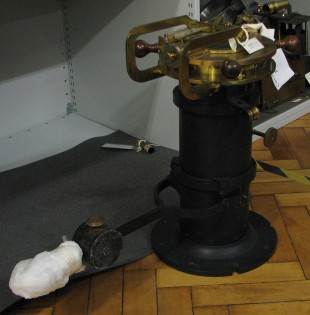…where east meets west
- Home
- Brief History
- The Greenwich Meridian
- Greenwich
(1675–1958) - Herstmonceux
(1948–1990) - Cambridge
(1990–1998) - Outstations (1822–1971)…
- – Chingford (1822–1924)
- – Deal
(1864–1927) - – Abinger
(1923–1957) - – Bristol & Bradford on Avon
(1939–1948) - – Bath
(1939–1949) - – Hartland
(1955–1967) - – Cape of Good Hope
(1959–1971)
- Administration…
- – Funding
- – Governance
- – Inventories
- – Pay
- – Regulations
- – Royal Warrants
- Contemporary Accounts
- People
- Publications
- Science
- Technology
- Telescopes
- Chronometers
- Clocks & Time
- Board of Longitude
- Libraries & Archives
- Visit
- Search
Telescope: Airy’s Reflex Zenith Tube (1851)
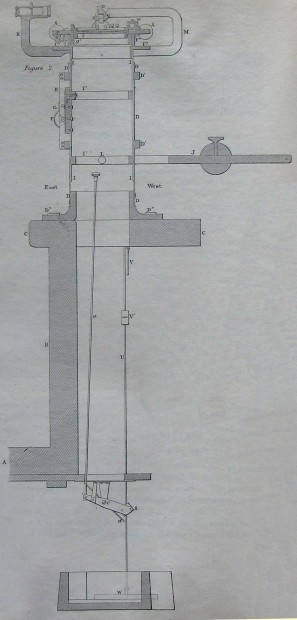
Airy's Reflex Zenith Tube. The height from top to bottom is about 5½ feet. From the 1854 Volume of Greenwich Observations
Superseded by Cookson’s Floating Zenith Telescope in August 1911, it was dismounted in April 1923 (when the room it was in was converted to a paper store) and placed in Case O of the lower Museum in the South Building. It appears to have subsequently been taken to Abinger to determine the latitude of the Magnetic Observatory and is recorded as being there in November 1929 (RGO39/4/5). Donated to the Science Museum in 1937 (Object No. 1937-692), it was loaned to the National Maritime Museum for exhibition purposes in 1967, where it was displayed in the Meridian Building until the 1980s. It is currently in store at the Science Museum.
Principle of the telescope
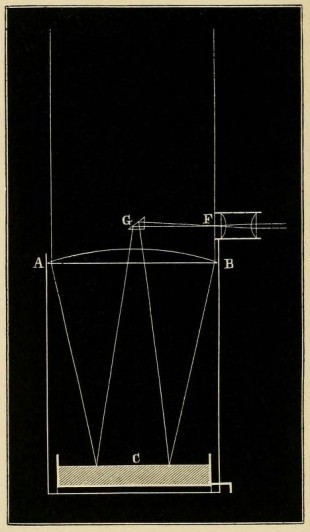
The principle of Airy's Reflex Zenith Tube. Fig. 131 from J Norman Lockyer's Stargazing: Past and Present (London 1878)
‘A, B, is an object-glass, fixed horizontally, and below it is a trough of mercury, C, the surface of which is always of course horizontal. The light from a star near the zenith is allowed to fall through the object-glass, which converges the rays just so much that they come to a focus at F, after having been reflected from the surface of the mercury, and also by the diagonal mirror or prism, G; at F, therefore, we have an image of the star, which can be examined together with the cross- wires at the eyepiece, M. There is in this instrument no necessity for the accurate adjustments that there is in the case of the transit, the surface of the mercury being always horizontal, and so giving an unaltering datum plane.
When the star is perfectly vertical, its image will fall on a certain known part in the eyepiece; but, as it leaves the vertical, the angle of incidence of its light on the mercury alters, and likewise that of reflection, so that the position of the image changes, and this change of position in the eyepiece is measured by movable cross-wires and a micrometer screw, similar to that employed for reading the circle in the transit circle.’
Description of the telescope
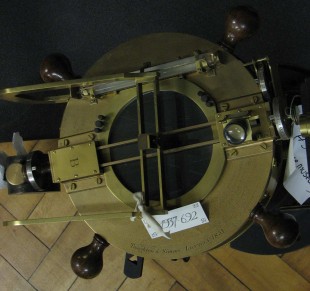
Airy's Reflex Zenith Tube from above. It is signed Troughton & Simms, London 1851. Photo taken in the Science Museum Store in 2009
‘The Reflex Zenith Tube, constructed under my direction by Mr. Simms. ... The object-glass (formerly the object-glass of Troughton’s Transit Instrument) is mounted upon a fixed tube, which is in a vertical position; upon this tube it can be turned in azimuth. To the cell of the object-glass is firmly fixed the micrometer frame, revolving with the object-glass when the object-glass is turned. The moving frame of the micrometer A carries the resting-point of the micrometer-screw of the micrometer B. The eye-piece is a 4-glass diagonal eye-piece, so placed that it can receive rays of light from the direction of the nadir, and can transmit them horizontally to the eye. The lens furthest from the eye, and the diagonal prism, are placed nearly over the center of the object-glass, carried by arms which are fixed to the large tube; the small tube carrying the remaining lenses of the eye-piece is supported by the large tube, and does not project over any part of the object-glass. At a distance below the object-glass, equal to half its focal length, is a trough of quicksilver. The image of the star, as it passes near to the zenith, is formed in the plane of the micrometer wires. These particulars will probably suffice for enabling the reader to understand the reductions. It will easily be seen that, for accuracy of result, no firmness of construction is requisite in this instrument, except in the connection between the micrometer and the object-glass.‘
The clock in the Reflex Zenith Tube Apartment was marked ‘Mudge and Dutton’. It was presented to the Observatory in 1846 by the Rev. Charles Turnor.
A problem with vibrations
To house the new instrument Airy, settled on a cupboard sized room in the Meridian Building that jutted out from the north east corner of the then Circle Room (the soon to be Transit Circle Room). Although the room appears to have been built as a single story onto the existing buildings between 1813 and 1831, its origins and original purpose are obscure.
The walls of the room were raised, and a flap shutter mounted on the roof. The floor on which the instrument was carried was raised about five feet above that of the Transit-Circle Room, and a pier carrying the mercury-trough built on a pyramidal stove-flue below it. It was the mercury that was to prove the locations undoing. Every time the adjacent courtyard gates were opened or shut, a jarring of the mercury would result. In 1853/4, Airy decided that a new room for the telescope should be constructed on the other side of the building in the recently created angle between the Transit Circle Room and the passageway behind his Official Room. Funding was not immediately forthcoming and it took until 1855 for the extension to be erected. As well as the telescope, the clock ‘Mudge and Dutton’ was also moved.
In the new location, the mercury trough was supported on a box of dry sand resting on the ground. But the mercury suffered from an intolerably large and never ceasing tremor. A well was therefore dug below the telescope and a stage erected at its bottom to support the trough of mercury. When no diminution in the tremor was observed, the well was dug deeper and deeper, and the support stage for the mercury trough adjusted accordingly. Digging was eventually stopped when, with the problems still unresolved, the well had reached a depth of ten feet – some seven feet below the building’s foundations.
It had by then been realised that the vibration problem was a result of the very structure of the hill itself, its compacted mix of sand and pebbles leading to the ready transmission of vibrations and tremors. The problem of transmitted vibrations does not appear to have affected the mercury troughs that began to be used with the Mural Circles in 1822, but did have serious implications for the Observatory in later years as the railways were extended and Greenwich Power Station was built nearby. The problem of the transmitted vibrations as they affected the Reflex Zenith Tube was mitigated by backfilling the well with ‘incoherent rubbish’ and suspending the mercury trough on a rather more complex arrangement of staging. This however was not the end of the problems with the design of the room. As originally built, the window (which was in the west wall), did not open. Those tasked with using the telescope were of the opinion that the star images would be rendered better if the ventilation in the room was improved. The window was accordingly altered in 1857/8. Given what is now know about the poisonous nature of mercury vapour, there was undoubtedly a beneficial effect on the health of the observers too!
Regrettably, the two rooms that had housed the Reflex Zenith Tube were both demolished during the conversion of the building for museum purposes in the 1960s.
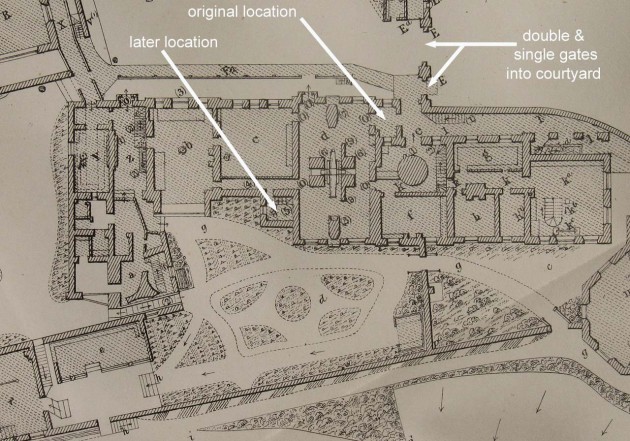
Ground Floor plan of the Meridian Building in 1863 showing the original and later locations of the Reflex Zenith Tube. (d) is the Transit Circle Room. Detail from a plan published as an appendix to the 1862 volume of Greenwich Observations
Discussions of the results obtained
Main, R. On the Value of the Constant of Aberration as deduced from Eight Years’ Observations of γ Draconis, from 1852 to 1859 inclusive, made with the Reflex Zenith Tube at the Royal Observatory, Greenwich (Memoirs of the Royal Astronomical Society, Vol. 29, p.169–190)
Downing, A. M. W.: Discussion of the observations of γ Draconis made with the Greenwich reflex zenith tube during the years 1857 to 1875 inclusive (Monthly Notices of the Royal Astronomical Society, Vol. 42, p.325–344)
Hall, A. The Greenwich Observations of γ Draconis, made with the Reflex Zenith Tube (Astronomische Nachrichten, volume 102, p.143 (1882))
Poor, C. L. The theory of the reflex zenith-tube and discussion of the observations of γ Draconis (Astronomical Journal, vol. 9, iss. 212, p. 153–155 (1890))
Chandler, S. C. The Greenwich reflex zenith-tube (Astronomical Journal, vol. 22, iss. 511, p. 57-60 (1901))
Meridian Zenith Distances of y Draconis, from Observations made with the Reflex Zenith Tube, 1886–99. (Appendix to Greenwich Observations, (1904))
Results of Reflex Zenith Tube Observations Made at the Royal Observatory, Greenwich, 1907–1911. (Appendix to Greenwich Observations, (1912))
Further Reading
Satterthwaite, G.E.: Airy's zenith telescopes and “the birth-star of modern astronomy” (Journal of Astronomical History and Heritage (ISSN 1440-2807), Vol. 6, No. 1, pp. 13–26 (2003))
© 2014 – 2026 Graham Dolan
Except where indicated, all text and images are the copyright of Graham Dolan
